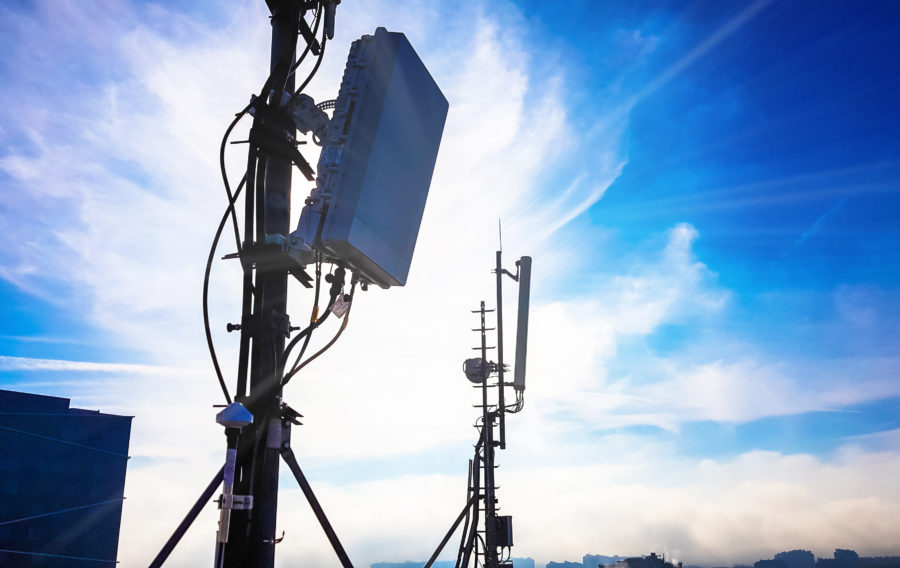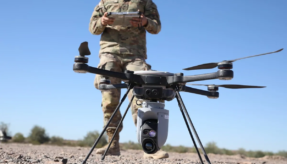
The next leap forward in information technology, 5G is a cause for excitement as well as contention. It allows for faster communications and high quality, fast downloads, but it has also raised concerns over security and health. Defence Online’s Ciara Houghton takes a closer look…
Using a higher radio frequency than 4G, 5G can transfer data up to 100 times faster, spanning between 1GHZ and 100GHZ frequency. This allows for high-quality downloads and streaming, making it a particular interest for gaming and entertainment companies. Military organisations have expressed interest in the technology, mainly as a means of transferring information.
Faster and more capable communications systems could be invaluable in military bases and on the battlefield. Advanced gaming software could also prove a big asset for training and battlefield simulations, taking in information and adapting to different scenarios in real-time. It also enables other technology with big military implications including Internet of Things (IoT) Artificial Intelligence (AI), drones, augmented reality, and unmanned vehicles.
An immediate risk with the introduction of huge technological capability is the new opportunities it creates for cyber attacks. IoT is made much easier with 5G, meaning multiple devices could be connected and therefore potentially compromised. Other futuristic technologies such as self-driving cars could also be made vulnerable to attack. The biggest threat is Denial of Service attacks (DDoS) which prevent devices being used through the exploitation of IoT systems.
The increased speed of connection with 5G means that a cyberattack could overwhelm more devices and systems in a shorter time. If not properly secured, 5G could increase the scale of attacks, shutting down huge organisations for days at a time. After recent cyberattacks on organisations including the NHS, some experts fear that hackers may be able to access weaknesses in ways that weren’t previously possible.
This presents a big risk factor if 5G becomes widely used across the armed forces for technology such as drones and self-driving cars. Enemy governments have been accused of hacking into government networks to interfere with processes such as elections, and experts fear a more connected military infrastructure could create similar weaknesses. Many defence organisations are exploring advances such as AI and IoT to power drone swarms, unmanned vehicles, and nanobots.
If an enemy could hack into these systems they could be easily compromised. Networks will have to adapt to new threats they haven’t faced before that will require additional security. Conspiracy theories also abound on the possible health risks of 5G, but scientists say they have found no solid evidence of risk associated with the technology.
The most well-known controversy surrounding 5G is the argument over Huawei. The Chinese company is offering cheap 5G installation, but many countries have raised security fears over its potential links to Chinese intelligence. The UK released a report condemning Huawei for failing to ensure the security of its networks.
The Huawei Cyber Security Evaluation Centre (HCSEC) released a report earlier this year that condemned Huawei’s security practices, but did not find evidence of espionage. The report stated that Huawei failed to act on reports of flaws in security networks. The UK has yet to make a decision on Huawei 5G, with Defence Secretary Ben Wallace promising a decision ‘very soon’. The UK’s National Security Council (NSC) agreed to allow Huawei to build some parts of the 5G network.
The government has referenced the previous behaviour from China in regards to cybersecurity as the foundation for its concern. However, British intelligence has claimed that any risk posed by Huawei 5G is ‘manageable’. Some countries have even gone as far as too ban them from installing 5G at all. The US has arguably had the strongest reaction to potential security threats. Washington has recommended its allies do not use Huawei 5G equipment, which is already in use in Bahrain, Saudi Arabia, and the United Arab Emirates.
Bahrain and UAE are home to US military bases and the US is planning to expand operations in Saudi Arabia. CIO of the US DOD Dana Deasy has recommended that the US focuses on creating its own 5G technology to ensure national security, especially in relation to infrastructure and application. The UK is expecting Huawei to address cybersecurity concerns and expects any possible threats to be manageable.
The US DOD is planning out its strategy to introduce 5G to its military infrastructure. The Pentagon is creating a list of bases that will serve as a testing ground for 5G. A report released in June this year from the Congressional Research Service detailed how the US plans to use 5G for intelligence, surveillance, reconnaissance, command and control, sensor networks, and autonomous vehicles. The plan for Autonomous vehicles is to use 5G to store large amounts of data in the Cloud.
The autonomous vehicles being developed across the military would use high data rates enabled by 5G to download off-board information and synthesise it using on-board data. The network could also be used to transfer information between vehicles and operators. It could also make it much easier to create a network of vehicles, enabling swarms of unmanned vehicles and drones. In Intelligence, Surveillance, and Reconnaissance (ISR) 5G could be used to process huge amounts of information from battlespace sensors. This would aid decision-making, allowing commanders to access intelligence in real-time.
The US military also plans to use 5G to improve command and control applications. Currently, the US uses satellites for long-distance communications, they hope 5G would reduce latency, using terrestrial network infrastructure for improving communication including teleconferencing. The US DOD is still acting with caution on these advancements, but are hoping to use encryption at the beginning of communications to protect data from adversaries during transmission. The same report recommends limiting intelligence shared with nations using Chinese 5G network infrastructure to avoid security risks.
The UK aims to become a ‘world leader’ in the deployment of 5G. The UK’s focus is mainly on the civilian use of 5G and improving connectivity in rural areas. Mobile network O2 is exploring how 5G could improve emergency services. They plan to use 5G to turn ambulances into portable consultation rooms, allowing paramedics to perform a wider range of treatments with online access to advice. The EU runs an annual Defence Innovation Prize seeking new technology and processes supporting the European Defence Agency (EDA) goals.
For the last two years, the competition has looked at applications for 5G in defence, as well as AI and IoT. This year’s prize looked at innovations combining 5G and AI. The prize is worth €30,000 and also looks at IoT and intelligence gathering. The EDA is seeking innovations that would improve EU defence capabilities between now and 2035. The second edition of the competition last year looked at innovative defence concepts that used 5G and IoT.
The competition sought large organisations as well as SMEs to submit concepts that would enhance specific EDA areas of interest. This year’s prize is seeking ideas that use 5G and AI to support decision making, improve the autonomy of unmanned systems, and improve intelligence gathering. The EU guidelines state that all public services should have access to a high-speed internet connection. The European Parliament has requested that the Commission create rules to improve competition, innovation, and investment to benefit all member states.
To learn more about cyber security and how your business can stay protected from threats, visit the Cyber Essentials Online website.
If you would like to join our community and read more articles like this then please click here.








